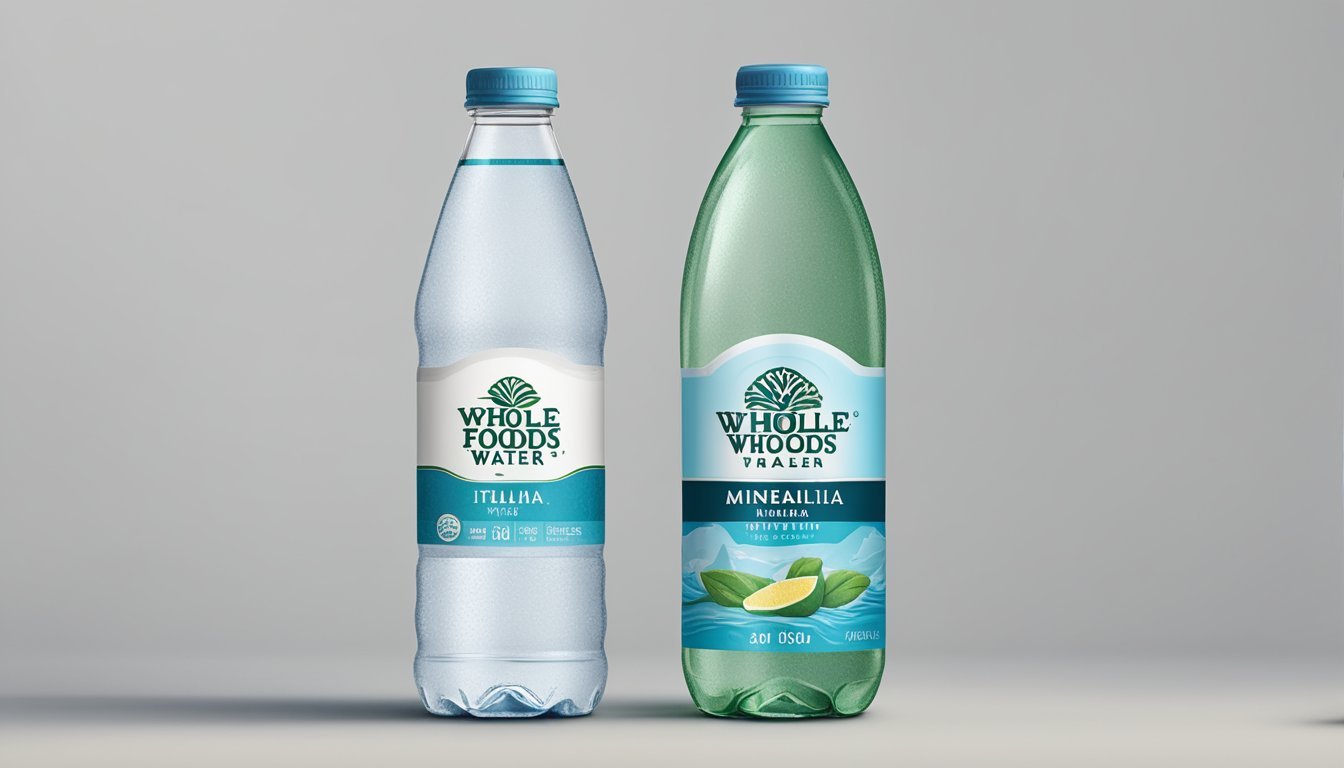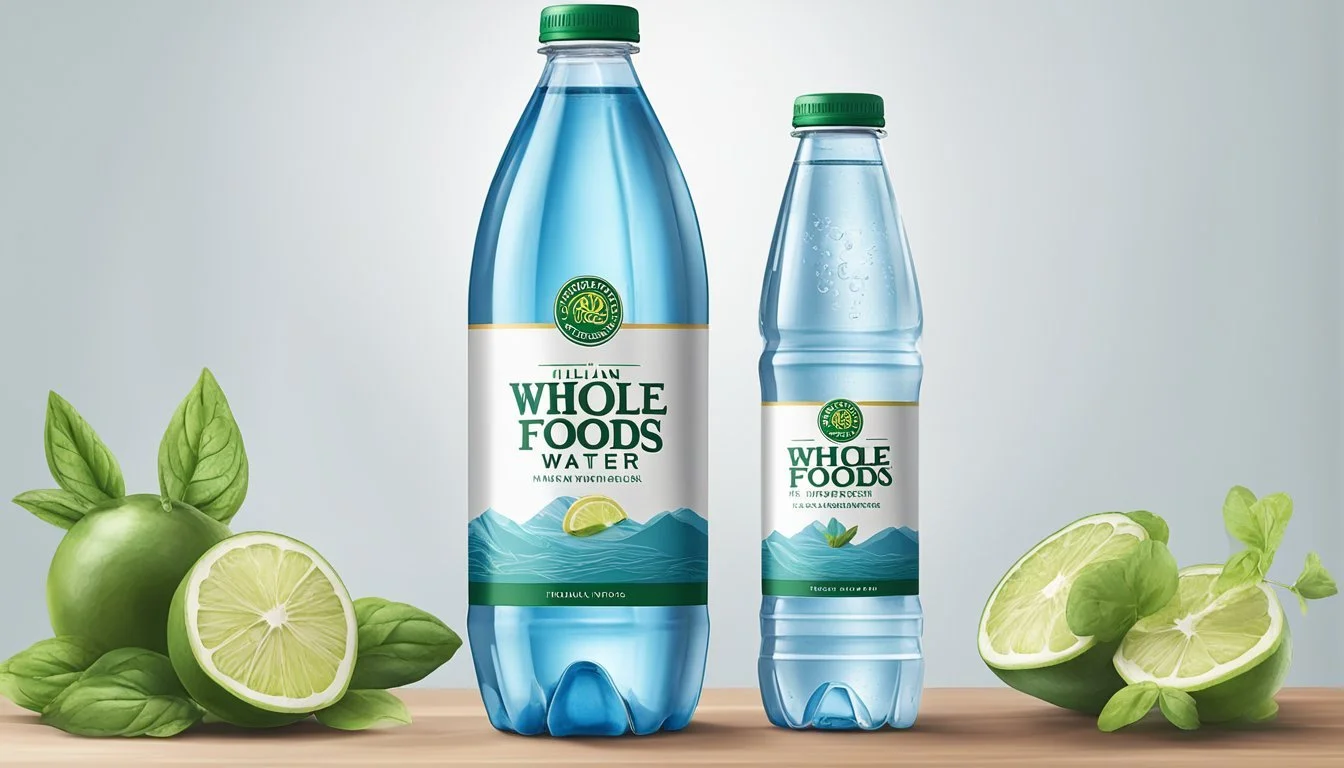Whole Foods Italian Still Mineral Water vs. Open Water
Best Bottled Water Comparison
When deciding between Whole Foods Italian Still Mineral Water and Open Water, consumers often weigh factors such as taste, source, and hydration benefits. Whole Foods Italian Still Mineral Water, known for its crisp taste and rich mineral content, is sourced directly from natural springs in Italy. Open Water offers a sustainable option in eco-friendly aluminum bottles, ensuring both quality hydration and environmental responsibility.
Whole Foods Italian Still Mineral Water stands out for its unique mineral profile, providing a refreshing and invigorating drinking experience. Sourced from the pristine springs in Italy, it delivers a distinct taste, making it a popular choice for those seeking premium bottled water.
In contrast, Open Water appeals to environmentally conscious consumers. Packaged in recyclable aluminum bottles, Open Water combines effective hydration with a commitment to reducing plastic waste. This makes it an excellent choice for individuals looking to make a positive environmental impact while staying hydrated.
Understanding Bottled Water
Bottled water offers unique attributes depending on its source, mineral composition, and quality controls. It is often chosen for its health benefits, purity, and hydration properties.
Source and Origin
The source and origin of bottled water greatly influence its characteristics. Whole Foods Italian Still Mineral Water, for instance, comes from the La Galvanina Spa Source in Rimini, Italy. This region is known for rich mineral springs dating back to the 16th century.
Conversely, Open Water is sourced from various rainwater and other weather systems. The origin dictates the water’s trace elements and overall mineral richness, contributing to its distinct taste and quality.
Mineral Composition
The mineral content in bottled water, comprising elements like calcium, magnesium, and potassium, is crucial for health and wellness. Whole Foods Italian Still Mineral Water contains naturally occurring minerals from its Italian springs.
Open Water undergoes filtration processes that may adjust its mineral profile. The mineral composition ensures that consumers receive hydration with added health benefits without unnecessary additives or contaminants.
Regulated Quality and Purity
Both Whole Foods Italian Still Mineral Water and Open Water undergo rigorous quality controls to maintain purity and safety. Imported from Italy, Whole Foods’ option is subject to both EU and US regulations, ensuring high standards.
Open Water, sourced domestically, also follows stringent guidelines under the FDA. Regular testing for contaminants, bacteria, and chemical residues ensures the water remains pure and safe for consumption.
Hydration and Health Benefits
Hydration is essential for maintaining bodily functions, and bottled water often provides additional health benefits. The minerals in Whole Foods Italian Still Mineral Water may improve bone health and support metabolic processes.
Open Water, known for its clean taste, ensures reliable hydration without harmful substances. Both options cater to consumers looking for wellness through clean, mineralized water that supports overall health.
By considering factors like source, mineral content, and purity, consumers can make informed choices about their bottled water preferences.
Comparison of Whole Foods Italian Still Mineral Water and Open Water
This section provides an in-depth look at the various aspects of Whole Foods Italian Still Mineral Water and Open Water, including their brand histories, taste profiles, nutritional content, and eco-friendly practices.
Brand Profiles and History
Whole Foods Italian Still Mineral Water is sourced from La Galvanina Spa Source in Rimini, Italy. Rimini is known for its rich mineral springs, which have been used since the 16th century. Whole Foods Market, a company dedicated to quality and sustainability, introduced this water to cater to those seeking premium bottled water.
Open Water focuses on sustainability. This brand offers water in 100% recyclable aluminum bottles. Their mission is to reduce plastic waste and promote environmentally friendly packaging. They position themselves as a leader in sustainable bottled water solutions.
Taste and Sensory Experience
Whole Foods Italian Still Mineral Water boasts a soft and refreshing flavor. Sourced from Italian springs, it has a light taste and is often described as crisp. This makes it a popular choice for those seeking a delicate mineral profile without overpowering flavors.
Open Water provides a similarly refreshing taste but with a slightly different profile due to its unique filtration process. The taste is clean and pure, with no hint of aftertaste. Its neutral flavor makes it versatile for different occasions and culinary uses.
Nutritional Contents
Whole Foods Italian Still Mineral Water contains various beneficial minerals. Key components include calcium, magnesium, and potassium. These essential minerals contribute to its health benefits, supporting hydration and overall well-being.
Open Water, while still hydrating, does not emphasize mineral content as much. It focuses more on providing a clean and pure drinking experience with a clear mineral balance. This makes it suitable for people who prefer minimal mineral content in their water.
Eco-Friendly Practices
Whole Foods Italian Still Mineral Water prioritizes sustainability. Their bottling process is designed to maintain the natural characteristics of the water while minimizing environmental impact. They utilize eco-friendly packaging and are committed to preserving the purity of the natural springs.
Open Water distinguishes itself through its total commitment to eco-friendliness. The use of aluminum bottles, which are infinitely recyclable, sets a high standard for sustainable practices. Their aim is to reduce plastic waste significantly and promote a more sustainable approach to bottled water consumption.
Analysis of Mineral Content and Health Impact
Understanding the mineral content of bottled waters like Whole Foods Italian Still Mineral Water and Open Water is essential for assessing their health benefits. Key areas of interest include digestion, bone health, cardiovascular health, and overall wellness.
Mineral Water and Digestion
Mineral water aids digestion by promoting enzyme activities and stimulating bowel movements. Whole Foods Italian Still Mineral Water contains minerals like magnesium, which can act as a mild laxative and encourage digestive health. Open Water, often sourced from purified water supplies, typically has fewer natural minerals, contributing less to digestive benefits. Those with digestive issues may benefit more from Whole Foods’ naturally mineral-rich profile.
Calcium and Bone Health
Calcium is vital for maintaining strong bones. Whole Foods Italian Still Mineral Water is known to contain a moderate amount of calcium, supporting bone density and reducing the risk of osteoporosis. Open Water, being purified, usually lacks substantial calcium content. Individuals looking to boost their calcium intake through water consumption might find Whole Foods Italian Still Mineral Water to be a more beneficial option.
Sodium, Blood Pressure, and Cardiovascular Health
Excess sodium intake can affect blood pressure and cardiovascular health. Whole Foods Italian Still Mineral Water typically has low sodium levels, making it suitable for those managing hypertension. Open Water, usually filtered to remove most minerals, also maintains low sodium levels. Both waters are thus appropriate choices for heart health, but Whole Foods offers additional minerals that may further aid cardiovascular functions.
Balanced Mineral Intake and Overall Wellness
Balanced mineral intake is crucial for overall wellness. Whole Foods Italian Still Mineral Water offers a variety of minerals such as magnesium and calcium, which support numerous bodily functions. Open Water’s low mineral content, due to purification processes, means fewer health benefits derived from mineral intake. Those aiming for a balanced diet with natural mineral sources might prefer Whole Foods Italian Still Mineral Water for its richer profile.
The Significance of Water Source and Natural Filtration
Understanding the origins and natural processes behind bottled water is crucial when comparing brands. The source and filtration methods significantly impact the taste, purity, and health benefits of the water.
Italian Natural Springs
Italy’s natural springs, like those in Tuscany and the Sibillini Mountains, are renowned for their purity. These springs provide water that is naturally filtered through geological layers, which enriches the water with essential minerals. The mineral content varies by region, contributing to the distinct tastes and health benefits of different bottled waters.
The springs' long history in Italy underscores their importance in providing high-quality water.
La Galvanina Spa Source
The La Galvanina Spa Source in Rimini, Italy, is a prominent water source for Whole Foods Italian Still Mineral Water. This region is celebrated for its rich mineral springs, which have been utilized since the 16th century. The water from this source is known for its balance of minerals and exceptional purity.
Extraction and bottling processes are carefully managed to preserve its natural characteristics, ensuring a product that is both high quality and refreshing.
Natural Filtration and Purity
Natural filtration processes play a vital role in the quality of bottled water. Water sourced from natural springs often undergoes filtration through layers of rock and soil, naturally removing impurities. This process enhances the water’s purity without the need for added chemicals or extensive purification techniques.
The natural filtration contributes to a cleaner, crisper taste and assures consumers of the water's safety and health benefits. The effectiveness of this natural method stands in contrast to some industrial filtration processes that may alter the water's natural composition.
Environmental Considerations and Sustainability
Examining the environmental impact of bottled water involves looking into sustainability practices in bottle production and how various brands emphasize eco-consciousness. Both Open Water and Whole Foods Italian Still Mineral Water take steps to address these concerns, but their approaches and effectiveness vary.
Sustainability Practices in Bottle Production
Whole Foods Italian Still Mineral Water uses packaging that aims to minimize environmental impact. Their bottles are often made from recyclable materials to promote reuse and decrease landfill waste. Whole Foods also supports sustainability by sourcing from regions known for their clean water, ensuring low environmental disruption.
Open Water stands out with its commitment to 100% recyclable aluminum bottles. Aluminum is infinitely recyclable, reducing waste far more effectively than traditional plastic. This approach supports a closed-loop recycling system, reducing reliance on new material extraction. Furthermore, Open Water partners with organizations to offset their carbon footprint, aiming for carbon neutrality.
Water Brands and Eco-Consciousness
Whole Foods emphasizes sustainability by maintaining eco-friendly practices throughout their supply chain. Their Italian Still Mineral Water promotes environmental responsibility by sourcing from specific regions in Italy known for sustainable water management. Whole Foods' broad sustainability framework includes efforts to reduce energy use and support local communities.
Open Water's eco-consciousness is reflected in their dedication to fighting plastic pollution. The brand's mission is clear: reduce plastic waste and promote sustainable hydration solutions. They achieve this by advocating for the use of aluminum, which has a significantly lower environmental impact compared to plastic. Additionally, Open Water supports environmental initiatives and educates consumers about sustainable choices.
Consumer Perspectives
Consumers are often swayed by the transparency of labels, the health benefits of the product, and the associations with an upscale lifestyle. These factors play a significant role in their purchasing choices.
Label Transparency and Consumer Trust
Clear and detailed labels on bottled water products significantly impact consumer trust. Whole Foods Italian Still Mineral Water clearly indicates its mineral composition, source, and purity levels, fostering a sense of reliability among buyers.
Open Water, on the other hand, prides itself on eco-friendly packaging, including a transparent label about its aluminum bottles. Both brands emphasize transparency to build and maintain consumer trust in a competitive market.
Premium Choice for Health-Conscious Consumers
Health-conscious consumers prioritize the health benefits of their bottled water choices. Whole Foods Italian Still Mineral Water is sourced from select springs in Italy, promising high purity and mineral content.
Open Water markets itself as a sustainable choice with its 100% recyclable aluminum bottles, appealing to consumers who are not just health-conscious but also environmentally aware. This premium positioning attracts those looking for unique properties in their hydration options.
Lifestyle and Upscale Dining Associations
Both Whole Foods Italian Still Mineral Water and Open Water align themselves with upscale dining and a refined lifestyle. The former is often associated with sophisticated dining due to its Italian origin and high-quality standards.
Open Water, with its minimalist, stylish packaging, fits seamlessly into the modern, eco-conscious lifestyle. This brand's unique taste and upscale image make it a favored option in premium dining settings, adding to its appeal among discerning consumers.
More About Whole Foods Italian Still Mineral Water
Acqua Pana vs Whole Foods Italian Still Mineral water: Which Bottled Water is Better?
Antipodes vs Whole Foods Italian Still Mineral water: Which Bottled Water is Better?
Aqua Carpatica vs Whole Foods Italian Still Mineral water: Which Bottled Water is Better?
Aquafina vs Whole Foods Italian Still Mineral water: Which Bottled Water is Better?
Arrowhead vs Whole Foods Italian Still Mineral water: Which Bottled Water is Better?
Bai vs Whole Foods Italian Still Mineral water: Which Bottled Water is Better?
Boxed Water vs Whole Foods Italian Still Mineral water: Which Bottled Water is Better?
Castle Rock vs Whole Foods Italian Still Mineral water: Which Bottled Water is Better?
Core Hydration vs Whole Foods Italian Still Mineral water: Which Bottled Water is Better?
Deer Park vs Whole Foods Italian Still Mineral water: Which Bottled Water is Better?
Erewhon vs Whole Foods Italian Still Mineral water: Which Bottled Water is Better?
Essentia vs Whole Foods Italian Still Mineral water: Which Bottled Water is Better?
Eternal vs Whole Foods Italian Still Mineral water: Which Bottled Water is Better?
Ethos vs Whole Foods Italian Still Mineral water: Which Bottled Water is Better?
Evian vs Whole Foods Italian Still Mineral water: Which Bottled Water is Better?
Fiji vs Whole Foods Italian Still Mineral water: Which Bottled Water is Better?
Flow vs Whole Foods Italian Still Mineral water: Which Bottled Water is Better?
Hawaii Volcanic vs Whole Foods Italian Still Mineral water: Which Bottled Water is Better?
Hawaiian Springs vs Whole Foods Italian Still Mineral water: Which Bottled Water is Better?
Ice Mountain vs Whole Foods Italian Still Mineral water: Which Bottled Water is Better?
Icelandic Glacial vs Whole Foods Italian Still Mineral water: Which Bottled Water is Better?
Just Water vs Whole Foods Italian Still Mineral water: Which Bottled Water is Better?
LIFEWTR vs Whole Foods Italian Still Mineral water: Which Bottled Water is Better?
Liquid Death vs Whole Foods Italian Still Mineral water: Which Bottled Water is Better?
Mananalu vs Whole Foods Italian Still Mineral water: Which Bottled Water is Better?
Nestle Pure Life vs Whole Foods Italian Still Mineral water: Which Bottled Water is Better?
Origin vs Whole Foods Italian Still Mineral water: Which Bottled Water is Better?
Ozarka vs Whole Foods Italian Still Mineral water: Which Bottled Water is Better?
Path vs Whole Foods Italian Still Mineral water: Which Bottled Water is Better?
Penta vs Whole Foods Italian Still Mineral water: Which Bottled Water is Better?
Perrier vs Whole Foods Italian Still Mineral water: Which Bottled Water is Better?
Poland Spring vs Whole Foods Italian Still Mineral water: Which Bottled Water is Better?
Purely Sedona vs Whole Foods Italian Still Mineral water: Which Bottled Water is Better?
San Pellegrino vs Whole Foods Italian Still Mineral water: Which Bottled Water is Better?
Smartwater vs Whole Foods Italian Still Mineral water: Which Bottled Water is Better?
Solan de Cabras vs Whole Foods Italian Still Mineral water: Which Bottled Water is Better?
Starkey vs Whole Foods Italian Still Mineral water: Which Bottled Water is Better?
Tahoe vs Whole Foods Italian Still Mineral water: Which Bottled Water is Better?
Topo Chico vs Whole Foods Italian Still Mineral water: Which Bottled Water is Better?
Tru Alka vs Whole Foods Italian Still Mineral water: Which Bottled Water is Better?
Volvic vs Whole Foods Italian Still Mineral water: Which Bottled Water is Better?
Voss vs Whole Foods Italian Still Mineral water: Which Bottled Water is Better?
Waiakea vs Whole Foods Italian Still Mineral water: Which Bottled Water is Better?
Whole Foods Italian Still Mineral water vs 1907water: Which Bottled Water is Better?
Whole Foods Italian Still Mineral water vs 7-Select: Which Bottled Water is Better?
Whole Foods Italian Still Mineral water vs Action: Which Bottled Water is Better?
Whole Foods Italian Still Mineral water vs Alkaline88: Which Bottled Water is Better?
Whole Foods Italian Still Mineral water vs Augi: Which Bottled Water is Better?
Whole Foods Italian Still Mineral water vs Big Chill: Which Bottled Water is Better?
Whole Foods Italian Still Mineral water vs Big Win: Which Bottled Water is Better?
Whole Foods Italian Still Mineral water vs Blk: Which Bottled Water is Better?
Whole Foods Italian Still Mineral water vs BodyArmor: Which Bottled Water is Better?
Whole Foods Italian Still Mineral water vs Cascade Mountain: Which Bottled Water is Better?
Whole Foods Italian Still Mineral water vs CBD Living: Which Bottled Water is Better?
Whole Foods Italian Still Mineral water vs Cirro: Which Bottled Water is Better?
Whole Foods Italian Still Mineral water vs Crystal Geyser: Which Bottled Water is Better?
Whole Foods Italian Still Mineral water vs Crystal Lake: Which Bottled Water is Better?
Whole Foods Italian Still Mineral water vs Dasani: Which Bottled Water is Better?
Whole Foods Italian Still Mineral water vs Defy: Which Bottled Water is Better?
Whole Foods Italian Still Mineral water vs Essence pH10: Which Bottled Water is Better?
Whole Foods Italian Still Mineral water vs HFactor: Which Bottled Water is Better?
Whole Foods Italian Still Mineral water vs Kirkland Signature: Which Bottled Water is Better?
Whole Foods Italian Still Mineral water vs Kroger: Which Bottled Water is Better?
Whole Foods Italian Still Mineral water vs Ophora: Which Bottled Water is Better?
Whole Foods Italian Still Mineral water vs Proud Source: Which Bottled Water is Better?
Whole Foods Italian Still Mineral water vs Pure Life: Which Bottled Water is Better?
Whole Foods Italian Still Mineral water vs Ramona: Which Bottled Water is Better?
Whole Foods Italian Still Mineral water vs Refreshe: Which Bottled Water is Better?
Whole Foods Italian Still Mineral water vs Richard's Rainwater: Which Bottled Water is Better?
Whole Foods Italian Still Mineral water vs Simple Truth: Which Bottled Water is Better?
Whole Foods Italian Still Mineral water vs Skyra: Which Bottled Water is Better?
Whole Foods Italian Still Mineral water vs Talking Rain AQA: Which Bottled Water is Better?
Whole Foods Italian Still Mineral water vs The Well: Which Bottled Water is Better?
Whole Foods Italian Still Mineral water vs Weird Water: Which Bottled Water is Better?
Whole Foods Italian Still Mineral water vs Whole Foods 365: Which Bottled Water is Better?
Whole Foods Italian Still Mineral water vs Zenwtr: Which Bottled Water is Better?
Zephyrhills vs Whole Foods Italian Still Mineral water: Which Bottled Water is Better?
More About Open Water
Aqua Carpatica vs Open Water: Which Bottled Water is Better?
Cascade Mountain vs Open Water: Which Bottled Water is Better?
Core Hydration vs Open Water: Which Bottled Water is Better?
Crystal Geyser vs Open Water: Which Bottled Water is Better?
Hawaii Volcanic vs Open Water: Which Bottled Water is Better?
Hawaiian Springs vs Open Water: Which Bottled Water is Better?
Icelandic Glacial vs Open Water: Which Bottled Water is Better?
Mountain Valley Spring Water vs Open Water: Which Bottled Water is Better?
Nestle Pure Life vs Open Water: Which Bottled Water is Better?
Open Water vs Kirkland Signature: Which Bottled Water is Better?
Open Water vs Whole Foods 365: Which Bottled Water is Better?
Richard's Rainwater vs Open Water: Which Bottled Water is Better?
San Pellegrino vs Open Water: Which Bottled Water is Better?
Solan de Cabras vs Open Water: Which Bottled Water is Better?
Talking Rain AQA vs Open Water: Which Bottled Water is Better?








